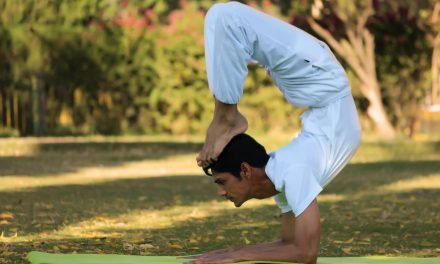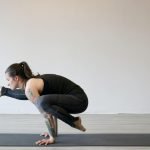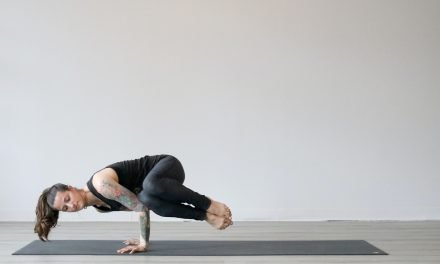
The Shoulder Stand – Upside Down For More Harmony

Some of you probably know the shoulder stand (Sarvangasana) from childhood: The “candle” was one of the exercises that I liked best in primary school physical education. At that time, however, I wasn’t really into yoga and therefore didn’t know what great effects the shoulder stand actually had – otherwise I would never have stopped practicing it.
Now, almost 25 years later, the asana has regained my love. That’s why we’re looking at the shoulder stand together today.
Step-by-step Instructions: This Is How You Get Into the Shoulder Stand
- You start lying on your back on your yoga mat. First, bring your legs together. The arms lie next to the body, the palms point down and rest on the floor.
- Now support yourself with your hands on the floor and bring your legs up. Advanced yogis bring their legs straight up – if that doesn’t work, you can bend your legs and then stretch them up.
- Next, you should lift your pelvis and back off the floor and straighten them straight up. Now only the head and shoulders rest on the floor. Make sure to support your back with your hands to relieve the spine.
Hold the position for a few minutes before leaving it in a controlled manner or switching to another asana, such as the plow.
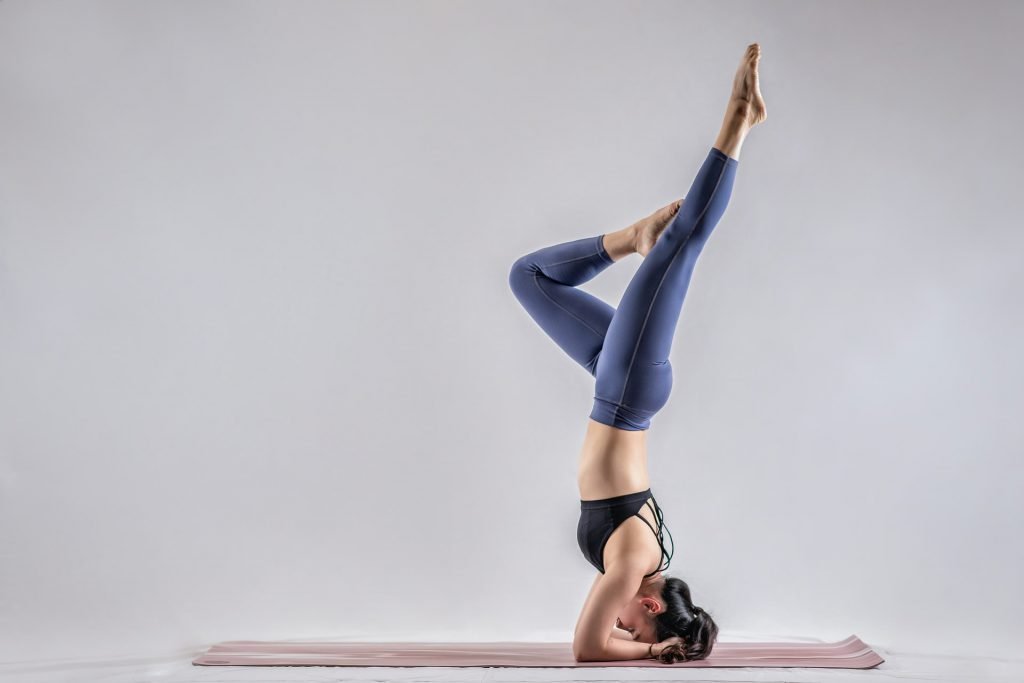
Typical Mistakes and How You Can Avoid Them
- The head is tilted: Please make sure to keep your head straight so as not to unnecessarily strain your neck and neck area. Guidelines on the yoga mat can be very helpful here, but a mirror or a selfie video can also do it.
- The head is moved: If you turn and move your head while performing the asana, this can lead to problems in the neck and neck area and subsequent headaches. Therefore, please keep your head still while you do the asana.
- You are too tense: The shoulder stand is not the easiest asana, and for many it is not necessarily the most comfortable either. Nevertheless, all muscles that you do not need to hold the asana should be relaxed – including the forehead and feet 🙂
- You forget to breathe: The chest is very compressed in Sirsasana – all the more you should concentrate on your breath and breathe deeply into your stomach. This is not only good for the bronchi, but also prevents stitching and makes the position more relaxed.
Effect of the Shoulder Stand – This Is What Makes Sirsasana So Healthy
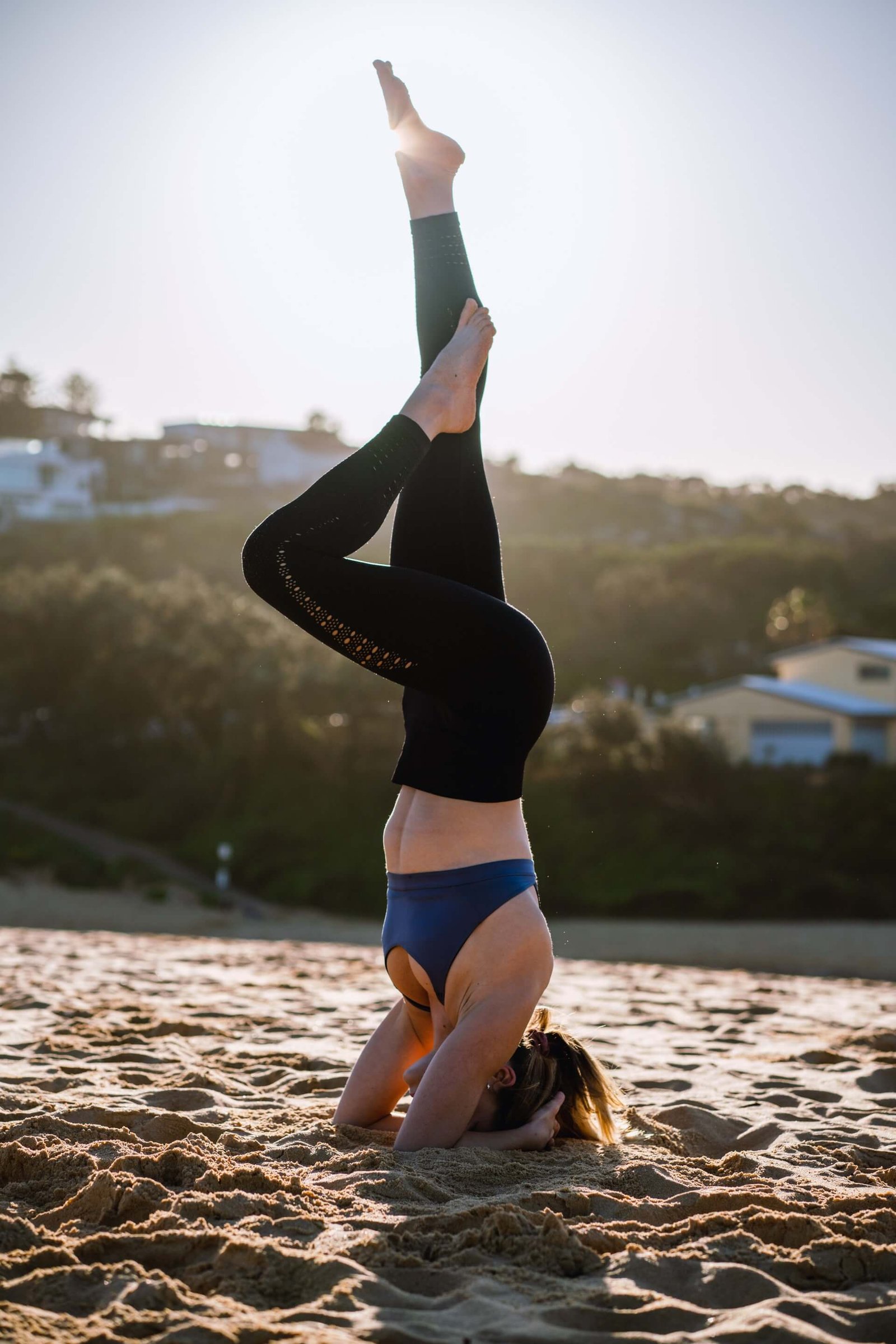
I already spoke briefly about the effect of the shoulder stand at the beginning – here we take a closer look at the effects of the asana:
Physical Effect
- As with all inverted poses, blood flow to the head is improved
- The pressure on the neck stimulates the thyroid gland, which stimulates the production of hormones.
- The shoulder stand is said to have a rejuvenating effect
- Abdominal breathing is forced through the tightness in the upper chest area. This can have a positive effect on asthma and bronchitis.
Spiritual Effect
- If the Sanskrit term “Sarvangasana” is translated, the shoulder stand can also be called the “position of all parts”. It should support you to feel connected and to lovingly accept life in all its facets.
- The shoulder stand has a harmonizing and balancing effect.
Energetic Effect
- From an energetic point of view, the shoulder stand harmonizes and activates the throat chakra, which sits at the level of the throat and is the center of communication – an activated throat chakra can thus help you speak your own truth.
What to Do if There Is Pain During or After the Shoulder Stand?
First of all: pain is not a good sign – in any asana. Please always pay attention to the signals from your body, especially when it shows you that a limit has been reached or exceeded here.
Headache or Neck Pain
If the head or neck becomes uncomfortable or even hurts during or after the shoulder stand, there can be various reasons. In most cases, the symptoms come from either tension or strains, for example because the head was not held straight in the shoulder stand or moved during the asana, or through sensitive vertebrae in the neck area that lie uncomfortably on the floor during the exercise.
If the pain persists for more than a few hours, it is advisable to see a doctor.
Back Pain
Anyone who has a bias on the back, for example, due to a herniated disc or the like, should be particularly careful with the shoulder stand and rather use one of the gentle variants.
Even without previous illnesses, the supported shoulder stand is ideal for back pain – here, too, the following applies: Yoga is not a competition and it is absolutely okay to work with aids. If you still want to practice the full shoulder stand, you should ensure that you support your back with your hands throughout and keep it as straight as possible.
However, if the pain persists, a doctor should be consulted.
Possible Variations and Modifications
The shoulder stand is considered the queen of asanas and is quite demanding – so it can be advisable to build up and practice it first in variations. The variations shown here are perfect …
- to learn the shoulderstand correctly and to build up the necessary strength and coordination
- with previous illnesses or pain in the full shoulder stand
- if the yoga session should be more relaxing and less demanding
- if the full shoulder stand is uncomfortable during your period
The Classic: the Supported Shoulder Stand With Pillows
For the supported shoulder stand, slide a pillow under your pelvis while lying on your back and lift your legs vertically off the floor. The back is not stretched vertically upwards but is only lifted slightly by the pillow.
The positive effects are retained. This makes the variation the perfect alternative for back problems or for a quieter yoga session.
For Sensitive Necks: the Shoulder Stand With a Blanket
In another variant of Sirsasana, the neck is relieved with the help of a blanket. To do this, a folded blanket is simply placed under the shoulders so that the head is slightly lower than the shoulders. This way the vertebrae in the neck and neck area do not press on the floor and the shoulder stand becomes more comfortable.
Attention: In this variant, please make sure that your elbows also have room on the ceiling and are elevated.
Popular With Pregnant Women: the Shoulder Stand on the Wall
If you want to do the shoulder stand on the wall, don’t start in a completely flat back position, but rather with your buttocks pressed against a wall, with your legs perpendicular to the wall.
Now you can “run up” the wall as far as it is comfortable for you. Please remember to support your back here too.
The variant on the wall is particularly popular during pregnancy. Here we would like to ask you to listen to your body in particular and if in doubt, speak to a doctor or attend a yoga class for pregnant women to make sure that you are doing the asanas correctly so that they are really good for you in the end.


